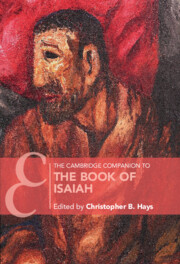Book contents
- The Cambridge Companion to the Book of Isaiah
- Frontispiece
- Cambridge Companions to Religion
- The Cambridge Companion to the Book of Isaiah
- Copyright page
- Contents
- Notes on Contributors
- Acknowledgments
- Timeline of Events Related to the Book of Isaiah
- Abbreviations
- Maps
- 1 Introduction
- Part I The Book of Isaiah Through History
- 2 The Book of Isaiah in the Neo-Assyrian Period
- 3 The Book of Isaiah and the Neo-Babylonian Period
- 4 The Book of Isaiah in the Persian Period
- 5 The Book of Isaiah at Qumran
- 6 Early Versions of Isaiah as Translations and Interpretations
- 7 The Formation of the Book of Isaiah
- Part II Isaiah in Its Cultural World
- Part III Isaiah as Literature
- Part IV Afterlives of the Book of Isaiah
- Scripture Index
- Other Texts Index
- Subject Index
- Cambridge Companions to Religion ()
- References
7 - The Formation of the Book of Isaiah
Foundations and Current Issues
from Part I - The Book of Isaiah Through History
Published online by Cambridge University Press: 08 November 2024
- The Cambridge Companion to the Book of Isaiah
- Frontispiece
- Cambridge Companions to Religion
- The Cambridge Companion to the Book of Isaiah
- Copyright page
- Contents
- Notes on Contributors
- Acknowledgments
- Timeline of Events Related to the Book of Isaiah
- Abbreviations
- Maps
- 1 Introduction
- Part I The Book of Isaiah Through History
- 2 The Book of Isaiah in the Neo-Assyrian Period
- 3 The Book of Isaiah and the Neo-Babylonian Period
- 4 The Book of Isaiah in the Persian Period
- 5 The Book of Isaiah at Qumran
- 6 Early Versions of Isaiah as Translations and Interpretations
- 7 The Formation of the Book of Isaiah
- Part II Isaiah in Its Cultural World
- Part III Isaiah as Literature
- Part IV Afterlives of the Book of Isaiah
- Scripture Index
- Other Texts Index
- Subject Index
- Cambridge Companions to Religion ()
- References
Summary
In “The Formation of the Book of Isaiah: Foundations and Current Issues,” Marvin A. Sweeney analyzes the history of scholarship about the editorial processes that gave rise to the Hebrew text as we have it. As scholars have long done, he takes Bernhard Duhm’s nineteenth-century commentary as a starting point, but then shows the myriad ways in which more recent scholars have challenged his presuppositions and greatly improved on his findings. In the process, he identifies many of the themes and features in the book that have led him and other interpreters to perceive a redactional shaping of the book in four major phases—broadly one per century in the eighth through fifth centuries bce. Sweeney’s most significant contributions to the study of Isaiah, reflected here, have been his demonstration of the Davidic covenant in the final form of the book and his refinement of our understanding of the Josianic layer from the late seventh century bce.
- Type
- Chapter
- Information
- The Cambridge Companion to the Book of Isaiah , pp. 100 - 116Publisher: Cambridge University PressPrint publication year: 2024

